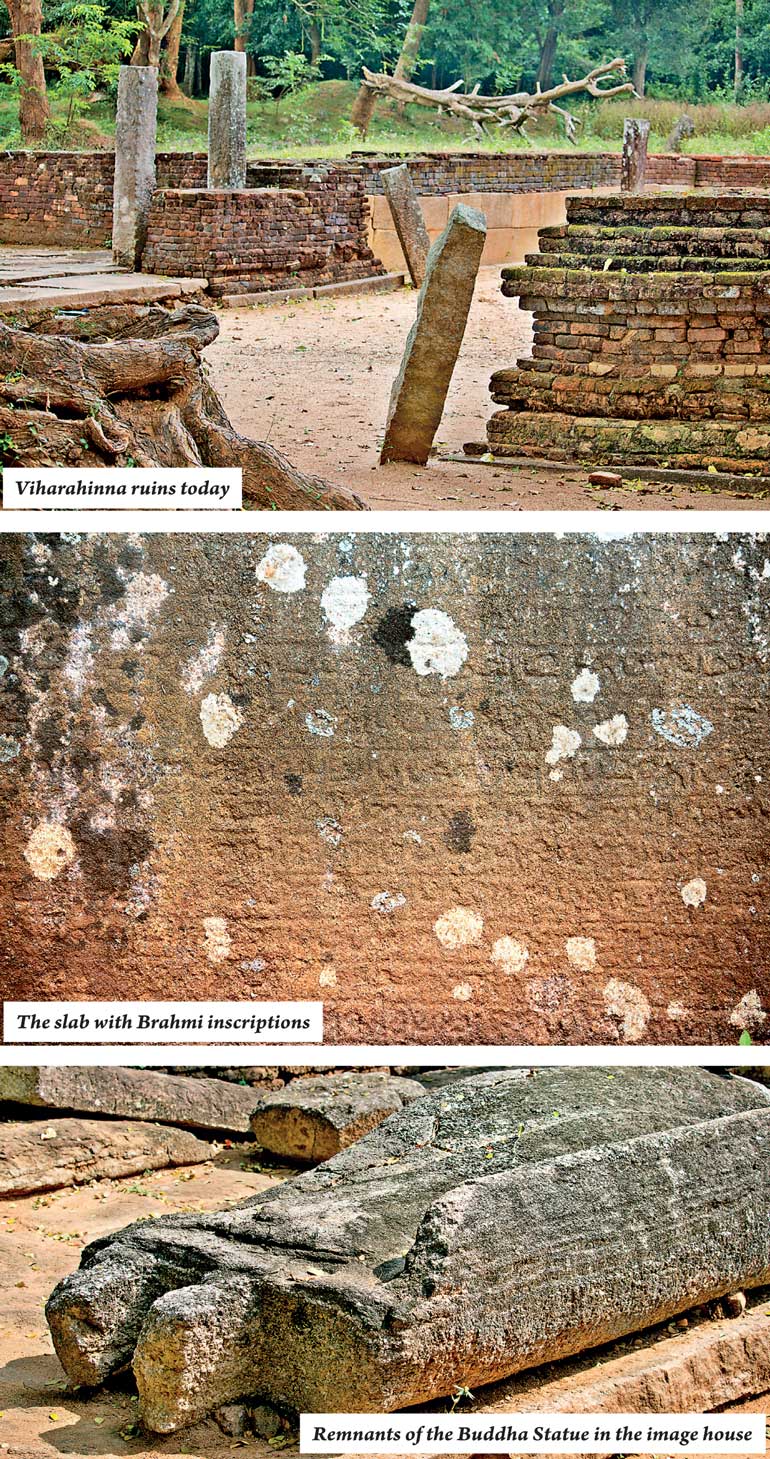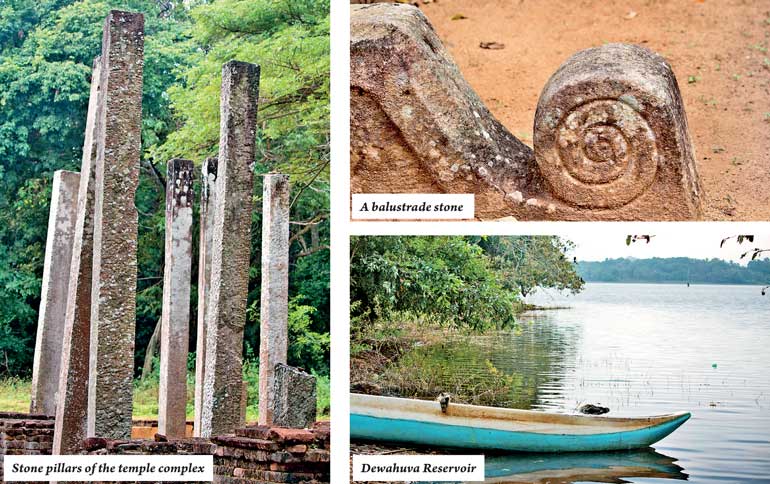Friday Mar 21, 2025
Friday Mar 21, 2025
Saturday, 17 February 2018 00:10 - - {{hitsCtrl.values.hits}}

By Aysha Maryam Cassim
Viharahinna is an ancient archaeological site found in a village called Moragolla located between the Matale and Anuradhapura districts. From Jathika Namal Uyana, it is a scenic 45 minute drive through Makulgaswewa, Bulanawewa and Dewahuva Reservoir.
If you make your way to Dambulla along the Kalawewa-Galewela road, take the left turn to Moragolla. In ten minutes, you can reach Viharahinna through a country road lined with paddy fields and streams. It is worth making a stopover here to absorb the unspoilt beauty of the surroundings. An hour past sunrise, we met a few fishermen who were heading to the banks after a successful morning catch at the nearby Dewahuva Reservoir. In their hands were two large fish known as Catla, a type of freshwater fish with a broad head and greyish scales. From what I was told, it does not taste as good as the famous ‘Wew Maalu’ (freshwater fish) Theppili but they make a good accompaniment to your rice and curry when deep fried.
This ancient tank which is located around Moragolla village has been abandoned since the 3rd century AD and was only reconstructed in the 1950s. The irrigation system acts as a main conveyance channel with a single embankment that feeds individual farm allotments in the village. West of the Dewahuva scheme is the Hevanalla Oya and east of the irrigated lowland is the scheme’s residential area. The tank has a water spread of 980 acres at full capacity. It is augmented by flows from Nawakka Ela, Kuda Oya and Kalu Gal Oya and irregular diversions from Nalanda Oya reservoir.
Temple in the jungle
The neighbouring forests of Moragolla village are a natural habitat for wild elephants where Veera, Palu and Kaluwara trees abound. The Viharahinna ruins are hidden in the wild among thick shrubs and trees and the historic site is hardly visible to the main entrance. The electric fence around the land indicates that the site is a zone where elephants roam. Make sure you visit the ruins in the morning hours just to be safe. Our guide, who was a resident of the nearby village, told us that the elephants usually come in herds mostly around 3-6p.m.
Most of what we know about Viharahinna is gathered from folklore passed on for generations through natives. According to village folk, Viharahinna is the site where King Dutugemunu (164 BC – 140 BC) rested on his way to the Wijithapura war. His mother, Queen Vihara Maha Devi joined him from Viharahinna. Upon victory, King Dutugemunu built a temple on this land and the name Viharahinna was attributed in honour of the Queen.
Viharahinna is in ruins today. It is difficult for us to imagine its original structure without sufficient archaeological and architectural evidence. Most of the excavated structures had been subjected to vandalism by treasure hunters. However, the remaining ancient brick foundation and tall stone pillars reveal traces of the hidden legacy behind Viharahinna.
Simple offerings
There is a simple ‘Sandakadapahana’ (moonstone) at the entrance of the image house and a few ‘Muragal’ (guard stones) and ‘Korawakgal’ (balustrade stones) on either side of the steps leading to the temple complex. The stonework had no visible ornamentation - this is something distinctive in Monastic architecture. Therefore, historians assume that Viharahinna could have been built as a ‘Panchavasa’ monastery complex which consists of fine features namely ‘Dageba’ (stupa), ‘Bodhiya,’ ‘Uposathagara’ (the chapter house), Image House and ‘Sangavasa’ (sanctum for monks).
At the chamber house lie the remnants of a fragmented granite image of Lord Buddha. The head of the statue has been destroyed by vandals and what is left today is the torso which measures around 11 feet in height. Adjoining the shrine room, there is a slab with a Brahmi inscription which mentions of a quarrel that took place between a village chieftain and members of a trade union. Experts believe that this could be an event which took place in the 12th century.
Viharahinna is one of the lesser-known, least visited ancient sites in Sri Lanka. Even though tourists do not frequent this place, local devotees who believe in its miracles often visit the ‘Devalaya’ (shrine room) situated in the temple premises with their faithful offerings. During the rest of the days, the land is occupied by four-legged guests from the wilderness, who seek shelter from the forest and its dangers after dusk.


Discover Kapruka, the leading online shopping platform in Sri Lanka, where you can conveniently send Gifts and Flowers to your loved ones for any event including Valentine ’s Day. Explore a wide range of popular Shopping Categories on Kapruka, including Toys, Groceries, Electronics, Birthday Cakes, Fruits, Chocolates, Flower Bouquets, Clothing, Watches, Lingerie, Gift Sets and Jewellery. Also if you’re interested in selling with Kapruka, Partner Central by Kapruka is the best solution to start with. Moreover, through Kapruka Global Shop, you can also enjoy the convenience of purchasing products from renowned platforms like Amazon and eBay and have them delivered to Sri Lanka.
Discover Kapruka, the leading online shopping platform in Sri Lanka, where you can conveniently send Gifts and Flowers to your loved ones for any event including Valentine ’s Day. Explore a wide range of popular Shopping Categories on Kapruka, including Toys, Groceries, Electronics, Birthday Cakes, Fruits, Chocolates, Flower Bouquets, Clothing, Watches, Lingerie, Gift Sets and Jewellery. Also if you’re interested in selling with Kapruka, Partner Central by Kapruka is the best solution to start with. Moreover, through Kapruka Global Shop, you can also enjoy the convenience of purchasing products from renowned platforms like Amazon and eBay and have them delivered to Sri Lanka.